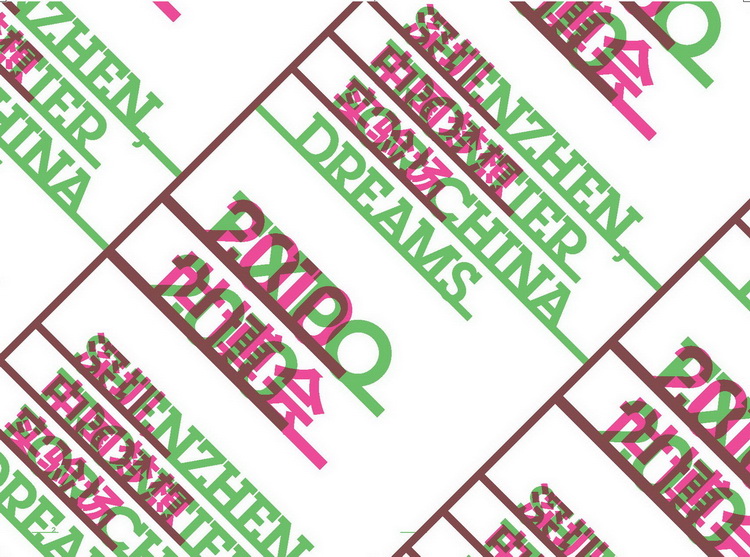
Expo 2010 Shanghai China Urban Best Practices Area Shenzhen Case Pavilion Booklet
MENG Yan/Chief curator
Features: a trilogy of trans-boundaries
A multiplicity of art forms such as contemporary art, experimental theaters and multimedia interactions are introduced into the exhibition space. We seek to absorb the strength of each art form, break conventional molds and present new ideas transcending the boundaries between different domains.
In the B3-2 hall of the World Exposition, there will be a fully-equipped, 43m×10m×7m complex theatre space, which will provide both exhibition services and theatrical experiences. It functions concurrently as a theater, an exhibition hall, and a live venue (interacting with another live scenes at Dafen in real-time). It offers multi-layered experiences, joining the Shanghai World Expo and Dafen village of Shenzhen together despite the geographical distances. It also transcends time boundaries in that, the whole process of exhibition design, pre-installation, interaction during the exhibition and post-exhibition promotion will break time constraints and extend the exhibition influence far and wide.
Transcending the boundary of domains:
With multi-diciplinary collaborations covering areas like architectural design, contemporary theater, multi-media interaction, visual system design, movie/documentary filming, publication planning and PR activities, we have the opportunity to collect the very best from each area. From design all the way through production, various areas both cooperate and compete with each other, all striving to impress their peers in their individual specializations. Meanwhile, because various links on the exhibition chain are interlocked with each other, this causal relationship between parties has prompted many new ideas and thoughts, with academic implications and artistic contributions going far beyond the exhibition itself.
Transcending the boundary of space:
The spatial constraint of the Shanghai World Expo is broken by extending the exhibition from Shanghai to Shenzhen city. The World Exposition comes at a time when Shenzhen is hosting the Shenzhen International Cultural Industry Fair, so we adopted a “twin exhibitions of two cities” strategy, i.e., the “Shanghai Exhibition Scene + Shenzhen Dafen Cultural Fair Scene to take full advantage of the two cities complimenting each other and raising our profiles in both areas.
Transcending the boundary of time:
Before the exhibition: At the academic and art workshop, scholars and artists are brought together to discuss a wide variety of subjects including city spirit, the regeneration of cities, rebuilding village-in-the-city, localization vs. globalization, the reproduction and originality of artwork, the public view and voice on arts, etc. Art events featuring collective creation were also held to better engage the general public into the exhibition.
During the exhibition: Real-time interaction between twin exhibition venues. Extending the exhibition to Shenzhen: The exhibition will be closed on October 31, 2010 when the World Expo draws to an end. By then the main framework of the large theatre can be transported back to Shenzhen for prolonged exhibition. Documentaries filmed during the exhibition can be submitted to international film festivals as well.
Post-exhibition research and publications: The academic and art workshop (i.e. the cross-boundary academic forum) will be held both prior to and during the exhibition in Shenzhen, with proceedings complied into publications later on.
Exhibition Design: a trilogy of spatial narrative
The Shenzhen pavilion is located in the B3-2 hall of the Urban Best Practice Area(UBPA)of the Shanghai World Expo, covering an area of 390m2. The existing building is a rectangular block covered with white fabric, inside which neighbors the Seoul, Korea case pavilion and the Bologna, Italy case pavilion. The Shenzhen case pavilion is designed as a closed, experience-emphasized exhibition space, appearing as a 43-meter-long, 9-meter-wide and 7-meter-high spatial theater installation. Normally visitors should wait in queues before they enter, and the number of inflowing visitors should be controlled. The entire pavilion is perfect integrated in and out, forming a symphony-like artwork with rich theatrical experiences.
The exhibition space and dramatic design work together to form a classical narrative genre, the trilogy. The trilogy originates from ancient Greece and is defined as a set of three plays connected by a coherent story line, also referred to as a triad. Now, the term is commonly used to refer to three independent yet connected works of art. The exhibition space employs the concept of “total artwork” coined by the German music composer Wagner as its starting point and basic idea, that is, the“gesamtkunstwerk”, a German word meaning “total”,“synthesis”, “the art of assemblage”, as illustrated by Wagner’s opera. It is a synthesis of music, poem, dance, drama and other artistic elements, with a special focus on the“total experience” generated by the entire piece. After entering into the pavilion, visitors will enjoy the prologue, first episode, second episode, third episode and epilogue sequentially, which are carried by well-organized installations across the space. The entire exhibition can be seen as a principal artwork, while various sub-artworks are exquisitely embedded into the larger artwork. These independent, yet interconnected artworks can be uninstalled after the event and sent to other major exhibitions both in China and abroad.
The spatial theatre installation comprises many scintillating and creative serial “experience zones” including: a large-scale oil painting installation, a multi-media imaging installation, a sample urban area experiential zone, historical documents of the village and a spatial theater installation. Visitors will first see a large and grandiose scene, and then as they walk further into the scene, he or she will discover numerous vibrant urban matrixes supported by interactive multimedia devices. Further along the way, the visitor will be lost in a labyrinth of tiny village full of human touches and an idyllic flavor. Finally, there comes the majestic urban theatre – the main theatre. Here, visitors are indeed masters of this urban living room. Amid those poetic, fantastic and relaxing scenes fostered by light, music and multimedia technology, they have an opportunity to explore the ultimate driving force of the city’s miracles created over the past thirty years, feel the dreams of local people and the spirit of this city: decisive, optimistic, and confident. Roaming through the space, people first go through high-density areas and then reach a large open space. This transition provides sharp contrast and a feeling of suddenly seeing the light – an epic experience, a climax of the entire drama.
